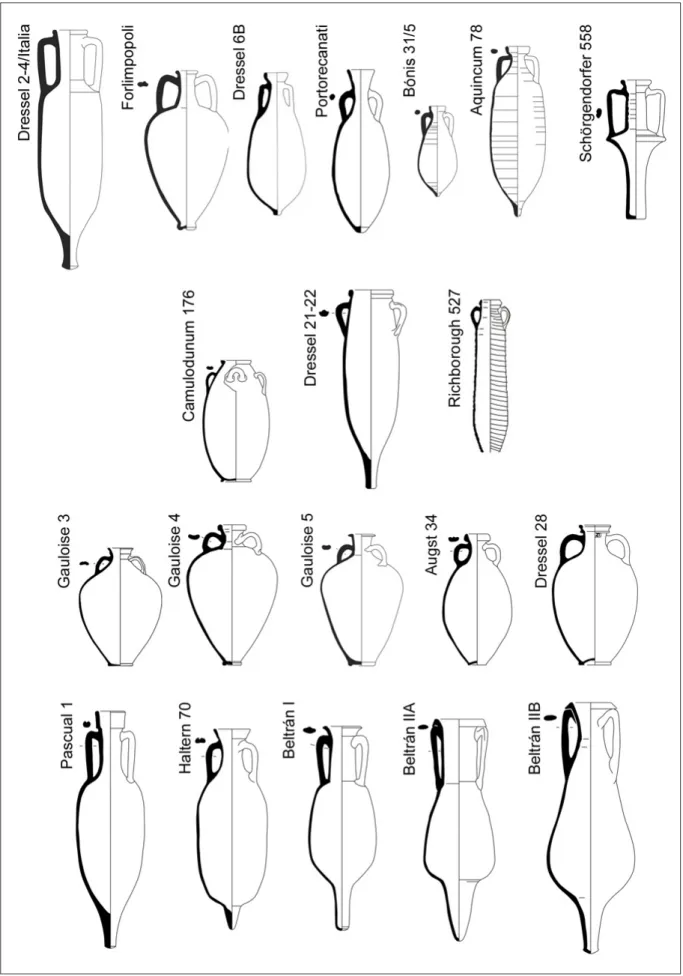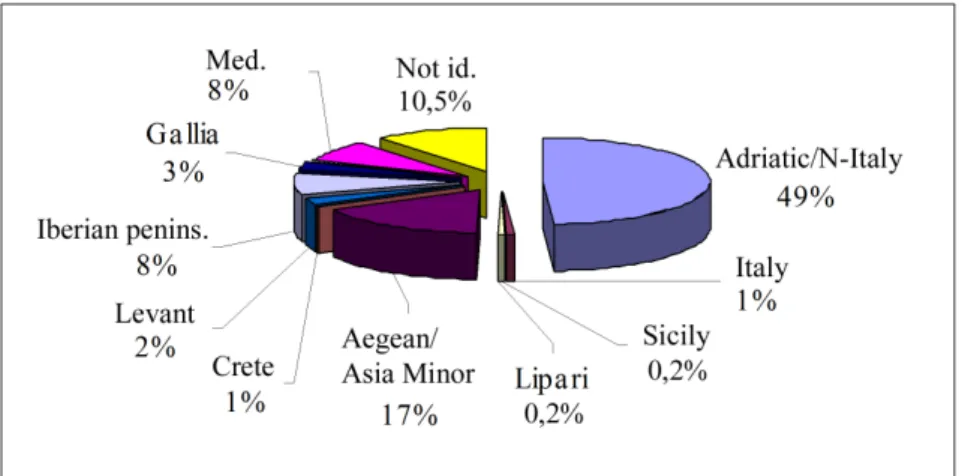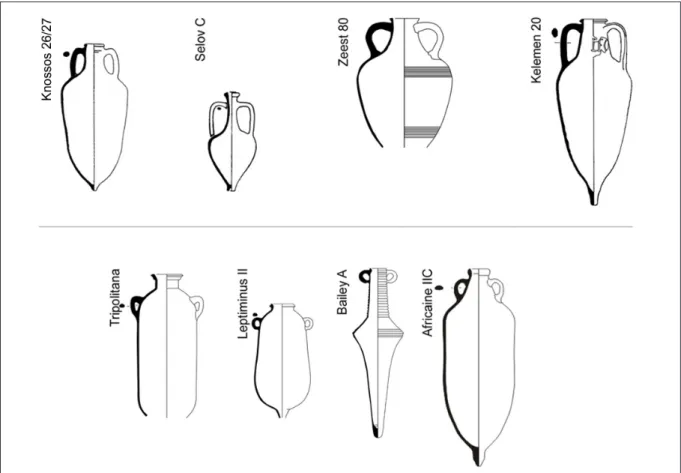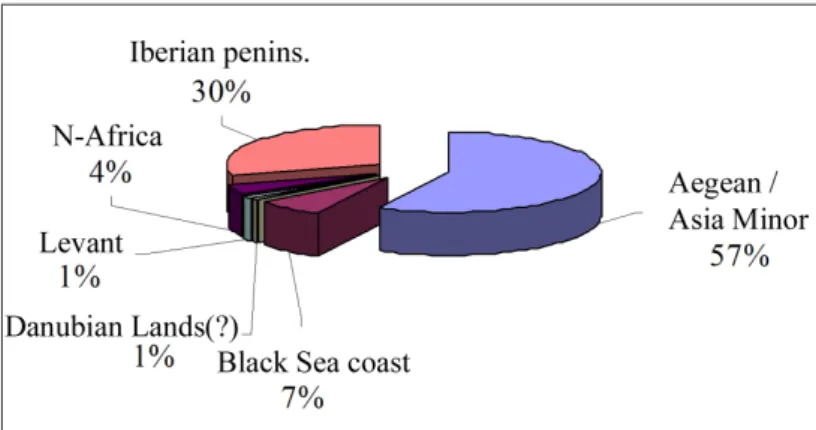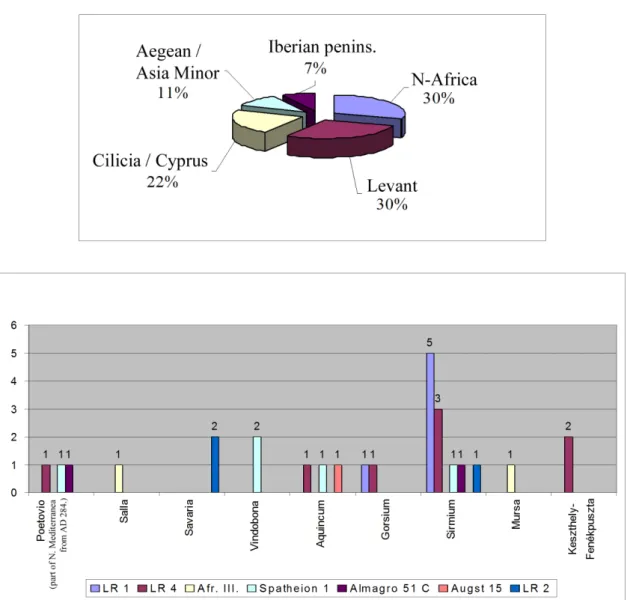Dissertationes Archaeologicae
ex Instituto Archaeologico
Universitatis de Rolando Eötvös nominatae Ser. 3. No. 4.
Budapest 2016
Dissertationes Archaeologicae ex Instituto Archaeologico Universitatis de Rolando Eötvös nominatae
Ser. 3. No. 4.
Editor-in-chief:
Dávid Bartus Editorial board:
László Bartosiewicz László Borhy Zoltán Czajlik
István Feld Gábor Kalla
Pál Raczky Miklós Szabó Tivadar Vida Technical editors:
Dávid Bartus Gábor Váczi
Proofreading:
Szilvia Szöllősi Zsófia Kondé
Available online at http://dissarch.elte.hu Contact: dissarch@btk.elte.hu
© Eötvös Loránd University, Institute of Archaeological Sciences
Budapest 2016
Contents
Articles
Pál Raczky – András Füzesi 9
Öcsöd-Kováshalom. A retrospective look at the interpretations of a Late Neolithic site
Gabriella Delbó 43
Frührömische keramische Beigaben im Gräberfeld von Budaörs
Linda Dobosi 117
Animal and human footprints on Roman tiles from Brigetio
Kata Dévai 135
Secondary use of base rings as drinking vessels in Aquincum
Lajos Juhász 145
Britannia on Roman coins
István Koncz – Zsuzsanna Tóth 161
6thcentury ivory game pieces from Mosonszentjános
Péter Csippán 179
Cattle types in the Carpathian Basin in the Late Medieval and Early Modern Ages
Method
Dávid Bartus – Zoltán Czajlik – László Rupnik 213
Implication of non-invasive archaeological methods in Brigetio in 2016
Field Reports
Tamás Dezső – Gábor Kalla – Maxim Mordovin – Zsófia Masek – Nóra Szabó – Barzan Baiz Ismail – Kamal Rasheed – Attila Weisz – Lajos Sándor – Ardalan Khwsnaw – Aram
Ali Hama Amin 233
Grd-i Tle 2016. Preliminary Report of the Hungarian Archaeological Mission of the Eötvös Loránd University to Grd-i Tle (Saruchawa) in Iraqi Kurdistan
Tamás Dezső – Maxim Mordovin 241
The first season of the excavation of Grd-i Tle. The Fortifications of Grd-i Tle (Field 1)
Gábor Kalla – Nóra Szabó 263 The first season of the excavation of Grd-i Tle. The cemetery of the eastern plateau (Field 2)
Zsófia Masek – Maxim Mordovin 277
The first season of the excavation of Grd-i Tle. The Post-Medieval Settlement at Grd-i Tle (Field 1)
Gabriella T. Németh – Zoltán Czajlik – Katalin Novinszki-Groma – András Jáky 291 Short report on the archaeological research of the burial mounds no. 64. and no. 49 of Érd- Százhalombatta
Károly Tankó – Zoltán Tóth – László Rupnik – Zoltán Czajlik – Sándor Puszta 307 Short report on the archaeological research of the Late Iron Age cemetery at Gyöngyös
Lőrinc Timár 325
How the floor-plan of a Roman domus unfolds. Complementary observations on the Pâture du Couvent (Bibracte) in 2016
Dávid Bartus – László Borhy – Nikoletta Sey – Emese Számadó 337 Short report on the excavations in Brigetio in 2016
Dóra Hegyi – Zsófia Nádai 351
Short report on the excavations in the Castle of Sátoraljaújhely in 2016
Maxim Mordovin 361
Excavations inside the 16th-century gate tower at the Castle Čabraď in 2016
Thesis abstracts
András Füzesi 369
The settling of the Alföld Linear Pottery Culture in Szabolcs-Szatmár-Bereg county. Microregional researches in the area of Mezőség in Nyírség
Márton Szilágyi 395
Early Copper Age settlement patterns in the Middle Tisza Region
Botond Rezi 403
Hoarding practices in Central Transylvania in the Late Bronze Age
Éva Ďurkovič 417 The settlement structure of the North-Western part of the Carpathian Basin during the middle and late Early Iron Age. The Early Iron Age settlement at Győr-Ménfőcsanak (Hungary, Győr-Moson- Sopron county)
Piroska Magyar-Hárshegyi 427
The trade of Pannonia in the light of amphorae (1st – 4th century AD)
Péter Vámos 439
Pottery industry of the Aquincum military town
Eszter Soós 449
Settlement history of the Hernád Valley in the 1stto 4/5thcenturies AD
Gábor András Szörényi 467
Archaeological research of the Hussite castles in the Sajó Valley
Book reviews
Linda Dobosi 477
Marder, T. A. – Wilson Jones, M.: The Pantheon: From Antiquity to the Present. Cambridge University Press. Cambridge 2015. Pp. xix + 471, 24 coloured plates and 165 figures.
ISBN 978-0-521-80932-0
The trade of Pannonia in the light of amphorae (1st – 4th century AD)
Piroska Magyar-Hárshegyi
Aquincum Museum harshegyi@iif.hu
Abstract
Abstract of PhD thesis submitted in 2016 to the Archaeology Doctoral Programme, Doctoral School of History, Eötvös Loránd University, Budapest under the supervision of Dénes Gabler
I. Previous research and research aims
1The comprehensive research of clay vessels (amphorae), made for the long-distance transporta- tion of imported liquid and consistent goods (wine, oil, fish sauce, fruit products, alum and oyster (?)), which appeared in Pannonia from the beginning of the 1st century AD has been started in the 1970s. Previous research included the regional collections undertaken in southern Pannonia by Olga Brukner, along the Amber Road by Tamás Bezeczky, and the work of Márta H. Kelemen, which covers the whole province.2Recently, parallel to this thesis Anna Nagy has collected data in Szombathely3and Baranya county.
The transportation of wine, oil, fish-based products, egzotic (preserved) fruits and olives were widespread from the Bronze Age in the Mediterranean and they were often packed into amphorae.4 This made possible for archaeological research to outline extended trade networks, politico-economical events and cultural changes. The primary aim of my thesis was to show the widest possible spectrum of amphorae, which arrived to Pannonia; to analyze their economic aspects, occasionaly pointing to political, military events and cultural movements. The interpretation of these factors helps a better understanding of the role of the province within the Roman Empire and the life of the inhabitants in the 1st to 4th centuries AD. It is important to underline that the main concern of amphorae finds in the research of Pannonia are related to the trade of the goods transported in them, which are good indicators of the culinary habits, economic relations and the emergence of the imperial tendencies. It was not possible to keep the chronological limitations pragmatically, since both the vessel forms and the history of the province required to review the history of the 1st century BC and it was also somewhat relevant to refer to finds from the 5th century AD or later. However, my time frame, which was set
1 I owe my thanks to my supervisor, Dénes Gabler, to my reviewers, László Borhy and Árpád Miklós Nagy, and to all my colleagues and friends who helped me in any way preparing my thesis. I owe my thanks above all to my family.
2 Brukner 1981, 45–46, 121-127; Bezeczky 1987; Kelemen 1987; Kelemen 1988; Kelemen 1990; Kelemen 1993.
3 Nagy 2014.
4 Peacock – Williams 1986, 20–30.
DissArch Ser. 3. No. 4 (2016) 427–438. DOI: 10.17204/dissarch.2016.427
Piroska Magyar-Hárshegyi
between the 1st and 4th century AD indicates the chronological limits, within which, according to my opinion, it is possible to talk about the import of amphora-borne commodities.
II. Methodology and Structure of the Thesis
The basis of the thesis is the data collected between 2000 and 2013 and recorded in an Access database. That database contains the published amphora material from Pannonian sites and those unpublished finds, which I had access to. All together I have analysed 2559 amphora finds from 49 Pannonian sites in this thesis. This is twice as many amphora finds as it was published previously from the province. Accordingly it was possible to double the number of identified types, which helped to improve our understanding of the trade of the province and the supply of the army, stationed in Pannonia. In the data collection, I have applied the internationally used Hamon – Hesnard method.5According that, primarily the diagnostic finds are counted of, mainly sherds where the exact typological classification had bigger likelihood (rim-, handle-, spike and bottom sherds) or had epigraphic data on them (they have inscriptions or stamps).
During the data collection I have made photo-documentation and/or drawings about the sherds.
I have also collected samples from the amphora finds and examined them under microscope in tenfold and twenty-fold magnification. A photo-documentation was made about the samples, so in the analysis it was possible to compare them to each other and to data from other databases.
The order of the typological classification of the amphorae in the thesis considers the place of production and the chronological framework. On the basis of that inChapter 2, I have the following sub-chapters for the different kind of amphora types:
1. Panprovincial type: Dressel 2-4, of which variants were produced in the whole Ro- man empire. Here I separately discussed the subtypes, found in Pannonia, which were manufactured in the eastern or western half of the Empire.6
2. Types made in the Eastern Mediterranean, the products of the western and southern coast of Asia Minor, the Levant and finally the types datable to the Late Roman period.
Here all together there are 20 (+1) types.7
3. The products made on the Adriatic coast and in the Western Mediterranean; here Italian, Histrian, Gaulish and Hispanian amphora types are discussed in order.8
4. The products of the Black Sea coast and the amphorae (supposedly) made in the Danube region got into the same section since the two areas had strong regional connections.
Here I review 4 types from the Black Sea coast and 2 types, which presumably were produced in the Danube region.9
5 Hamon – Hesnard 1977.
6 Aegean and Eastern Mediterrabean subtypes; subtypes made in North Italy, Campania, Calabria/Sicily, Apu- lia/South Illyria, Istrian peninsula, Gallia Narbonensis, Hispania Tarraconensis, Hispania Baetica.
7 Dressel 25(?); Dressel 24; Dressel 5 and Knossos 22; Rhodian; Amphore Crétoise 4; Amphore Crétoise 3;
Pompeii 38; Anfore monoansate; Kapitän II; Kapitän IIsimilis; Agora G199; Grace 13(?); Camulodunum189;
Kingsholm 117; Augst 46; Augst 47; Agora M177; Late Roman 1; Late Roman 2; Late Roman 4.
8 Lamboglia 2; Dressel 6A, Forlimpopoli; Ante Dressel 6B; Dressel 6B; Porto Recanati; Aquincum 78; Schörgendorfer 558; Camulodunum 176; Dressel 21-22; Richborough 527(?); Gauloise 3similis; Gauloise 4; Gauloise 5; Augst 34;
Dressel 28; Pascual 1; Haltern 70; Beltrán I; Beltrán IIA; Beltrán IIB and Augst 30; Dressel 20; Almagro 51C.
9 Knossos 26/27 and Knossos 36; Zeest 80; Kelemen 20; Šelov B/C; Radulsecu 3A; Bojović 549/554.
428
The trade of Pannonia in the light of amphorae (1st – 4th century AD)
5. In the typological classification the next area, I discuss is the North African region, of which production is differ in form from the hitherto listed types. For the time being I could separate products, which belong to 7 different types, or rather group of forms in the Pannonian material.10
6. In several cases, for the present, we do not have any base in respect of the production site of otherwise well described amphora types.11
7. Finally I deal with the (temporarily) not correctly identifiable sherds, since in the amphora research the full spectrum of forms, which made in the area of the Roman Empire is not known, the identification and description of these is constantly happening. The common characteristics of these finds is that on the basis of the quality of their material local (Pannonian) production can be excluded and on the basis of their forms they supposedly functioned as transporting vessels. Conceiveably, these sherds in course of time could help the development of new research directions, this is why I featured them in this thesis.
The typological classification is followed by the analysis of the finds according to sites in Chapter 3. The 49 studied sites were listed according to the important routes of the Pannonian road-network, considering the former function of the sites (provincial centres, military forts and theirvici, villas or villa-like environment). Sometimes I could only made an attempt to determined the function of the site.
Chapter 4contains the results of such background research, which were vital regarding the arrival of amphorae to the province. Hence it was important to examine the methods, which were needed for the reconstruction of their transportation (on sea, river and land). Here I have also discussed the finds from sites in the vicinity of the borders of Pannonia, outside of the territory of the Roman Empire, which somewhat illuminate the transit-like nature of the province. In this chapter I tried to collect the epigraphical data and ancient sources on which this research is based. Similarly to the transportation routes and methods it was important to deal with the individuals, who took part in the transportation and other momenta of commerce from the wholesalers/military subconstarctors through to commercial organisations to the consumers.
Their recognition is mainly based on the inscriptions, although their occurance is quite incidental in case of Pannonia. The last sub-chapter of Chapter 4 deals with the superior commercial division into which Pannonia is belonged, namely thepublicum portorii Illyricicustoms district. I also cover the rate of the customs, which for the time being cannot be determined safely.
Chapter 5 contains the results that can be drawn from the foregoing and synthesize the commercial-economic tendencies observable in Pannonia. This followed by three such an ap- pendicis, which summarize the results of some particular research or if necessary confirms by further information some formerly discussed issues. HenceAppendix 1contains the results of the so far unpublished results of the petrographical analysis, made jointly with the Department of Petrology and Geochemistry of the Eötvös Loránd University, into which György Szakmány and Sándor Józsa took part. This microscopical examinations provided important data for the production place of particular amphora types and for the production technology.
10 Tripolitana-types; Leptiminus II(?); Bailey A(?); Africaine II; Africaine III; Augst 15; Spatheion 1.
11 Bónis XXXI/5; Kelemen 10.
429
Piroska Magyar-Hárshegyi
Fig. 1a.Amphora types in Pannonia in the first period: amphorae produced in the Western Mediterranean (drawings: http://archaeologydataservice.ac.uk/archives/view/amphora_ahrb_2005).
430
The trade of Pannonia in the light of amphorae (1st – 4th century AD)
During the preparation of the thesis another petrographical research was undertaken in the coopera- tion of the Museum of Aquincum, the Università degli Studi di Pisa and the Università degli Studi di Genova DISTAV Department, during what we have examined the finds from the roman urban villa of the Meggyfa Street in Budapest.12InAppendix 2, I have summarized the knowledge about the viticulture and wineculture of Pannonia, which provided important information about the changes in the amount of amphorae containing wine from the middle of the 2nd century AD. InAppendix 3, I deal with a complementary topic, the Roman barrel finds in Pannonia, since the information, collected about them can help in the apropriate interpretation of the wine imported in amphorae.
The text of the thesis are closed by the bibliography, the catalogue of finds, the drawings and photographs of the partly unpublished amphora finds, the plates of the samples made by a microscope together with maps about the geographical range of the major types.
III. Results of the Thesis
The amphora finds, noticeable from the earliest (Tiberian and Claudian) period ususally turned up along the main procession roads, which in this case are the roads along the Save and the Drave, just as the Amber Road. This group of finds are cannot be interpreted any more as individual gifts to the local Celtic aristocracy in the previous period.13 On the basis of their small amount, it is probable that they were not for the persistent supply of the whole army, but they were demanded by officers, who arrived from the Mediterranean.14
Fig. 1b.Amphora types in Pannonia in the first period: amphorae produced in the Aegean / Asia Minor, on the coast of the Levant, in the Danubian Lands, and amphora type of unknown origin (drawings:
http://archaeologydataservice.ac.uk/archives/view/amphora_ahrb_2005 and Bojović 1977).
12 The results are published: Menchelli et al. 2008.
13 Ilok: Dizdar 2012, 128, fig.13; Staré Hradiste: Meduna 1974, 114; Velem-Szentvid: Guillaumet et al. 1997, 387; Szabó et al. 1994, 122–123; Budapest, Gellérthegy: Póczy – Zsidi 2003, 186.
14 Magyar-Hárshegyi 2016, 628–629.
431
Piroska Magyar-Hárshegyi
On the territory of Pannonia, wine was not produced previously the Roman conquest, we have no data for fish sauce making, and olive plantations could never come to stay in this region. It is important to emphasize, that the amphorae are foreign objects, foreign goods and by this they carry foreign culinary habits in the area of the future Pannonia in the age of the conquest of the province.
From the late Claudian period and from the reign of Nero the sites along the Danube were closing up to the Amber Road, as well. By the age of Domitian this two main transport routes became equally important. The age of Hadrian and the Early Antonine period are clearly shows a peak in the amount of imported goods, transported in amphorae. To sum up, the period between Tiberius and the Hadrian/Antonine period, this can be the 1st period into which the 72.6% of the material collected from the province belong.15 The finds have a diverse spectrum in terms of their forms, with 45 different types or subtypes(Fig.1a–b)from 43 sites. In the initial cycle of this period (1A: from the age of Tiberius to the Flavians) the Hispanic and Gaulish products were still present. From the Flavian period to the Antonine period (1B) they were clearly took over by the North-Italian and Histrian production. The share of these two in the Pannonian market are about 50% over against the Gaulish and Hispanic goods of the early period, of which share is about 11%. The Eastern and Aegean import in this period is 19.6% (Fig.
1c). In the first period we could still take into account such luxury products as the dates/figs from the Levant, transported in Camulodunum 189 type amphorae or olives, transported in the Schörgendorfer 558 type amphorae.
Fig. 1c.Places of origins of imported amphorae in Pannonia in the first period.
By the late Antonine period the number of amphorae along the Amber Road drastically drops, in the centres along thelimestheir number stagnates. I could separate 17 types (Fig. 2a–b) from 27 Pannonian sites, which were datable between 150/160 AD and 260/270 AD. The vigorously decadent tendencies are particularly shown by the fact that only 18.4% of the amphora finds are datable to this second phase. 57.5% of this amount are wine and oil amphorae from the Aegean and 29.5% are oil amphorae from Hispania (Fig. 2c). The Marcomannic Wars show a definite break in the volume of the import. In the same time, from then on a new supply road came into view: products from the Black Sea coast appear (mainly vessels for transporting wine and fish sauce), which have a share of 6.8% of the market (Fig. 2b).
15 For the previous periodization, see Bezeczky 1995.
432
The trade of Pannonia in the light of amphorae (1st – 4th century AD)
Fig. 2a.Amphora types in Pannonia in the second period: amphorae produced in the Aegean / Asia Minor, on the coast of the Levant and on the Iberian peninsula. (drawings: http://archaeologydataservice.ac.uk /archives/view/amphora_ahrb_2005 and the author).
Fig. 2b.Amphora types in Pannonia in the second period: amphorae produced on the Black Sea coast and in North Africa (drawings: http://archaeologydataservice.ac.uk/archives/view/amphora_ahrb_2005 and Kelemen 1990).
433
Piroska Magyar-Hárshegyi
In the case of Pannonia it is possible that they arrived on barges on the Danube to their currently known Pannonian find spots, Aquincum and from there to Albertfalva. The presence of the North African amphorae is a novelty, compared to the first period (Fig. 2b). Their share is about 2.9% in the recorded material. The drastic drop in this second phase can be interpreted by the more standardized military supply system, which focused on local provisioning and low-quality supply.16 It is widely possible that the inhabitants of Pannonia in this period partly unclaimed these amphora-borne commodities, or more likely, they couldn’t afford consuming these luxurious goods. It is higly likely that Pannonia was self-sufficient in the case of wine or it was easily available in barrells from the neighbouring provinces at that time.
Fig. 2c.Places of origins of imported amphorae in Pannonia in the second period.
On the basis of amphorae stamps, which refer to the place of production, it seems that the last period of military supplies, which arrived in amphorae can be dated to 250/270 AD. By this period the import of amphora-borne commodities drastically drops, and is virtually non-existent on the Amber Road. The hinterland looks like a ’deserted island’ on the maps, with only some sparse finds. It is especially true to the area south of the Lake Balaton and until to the river Drave, where it after an aimed research it has been proven that there were virtually no amphorae in the finds material. This does not necessarily means the absolute absence of the products imported in amphorae in this area, since it is possible that in smaller quantities (in jars or smaller vessels) some of these imported goods has arrived to this area, as well.17 Nevertheless the presence or absence of these products is an important factor, since the amphorae do not appear randomly or as a trial on the market, but to satisfy the demands of particular circle of consumers.18
Hence, the last, third period of the import of amphora-borne commodities in Pannonia starts in the middle–third quarter of the 3rd century AD and in my opinion it is discernible until the end of the 4th century AD. Only 1% of the total amount of amphora material belongs to this period. It is very hard to associate content to the types of this period, therefore it is difficult to estimate the real amount and importance of the imported goods. The Late Roman types, which appear in this period (Fig. 3a–b) are on the typical Mediterranean spectrum, which is associated to supplying the army.19 On the provincial level, the change of the culinary culture
16 Mainly from the Severan era, see Lo Cascio 2009, 153.
17 A very good example of repackaging foreign goods (e.g. olives) into locally made jars, see Ehmig 2007, 84–86.
18 Howells 2009, 77.
19 Hárshegyi – Ottományi 2013, 484–486.
434
The trade of Pannonia in the light of amphorae (1st – 4th century AD)
could determine this picture20, but this was also part of the greater process, which characterised the whole Roman Empire and in which background there was the economical division of the Empire, caused by the external and internal insecurity.21
Fig. 3a.Amphora types in Pannonia in the third period (drawings: http://archaeologydataservice.ac.uk /archives/view/amphora_ahrb_2005 and Martin-Kilcher 1994).
The investigation of the composition of finds from Pannonia and from the sites along the transportation routes ran to the province (mainly from the Adriatic Sea) showed that it is incorrect to suppose only direct commercial contacts between Pannonia and the other provinces of the Roman Empire. I have found more valuable to investigate the character of the commercial connections of the province through the contacts of the military units, the clerks and the customs district of Illyricum. In the province no inscriptions were found, which mentioned anolearius or avinarius, however it was possible to make some attempts, with the help of the inscriptions referring tonegotiatoresand known merchant families, to outline that social stratum, which were engaged in the trade of the goods, transported in amphorae and also were consumers of these products. The offsprings of these families were often held the particular function of the officium consularis, who ran the provincial military supply and also appeared in the governance of major Pannonian settlements. Among the consumers of the products arrived in amphorae, the members of the provincial elite and civil servants can be suspected.
20 Davies 1989, 188; Carreras Monfort 2002, 87.
21 Reynolds 2010, 73–74, 142; Corbier 2009, 393.
435
Piroska Magyar-Hárshegyi
Fig. 3b.Places of origins of imported amphorae and their finding places in Pannonia in the third period.
However the greater part of amphora material of Pannonia arrived as packing vessels of the military supply to the province, which is shown by the geographical range, just as by the distribution and quantities of the finds. The contacts and common interest of the military personnel, theconductoresin the customs offices and the merchants could be a determining factor in the aquisition of the military supply. In the period, which followed that, from the 180s AD, the customs policy, the system of the military supply and the combination and quantity of amphora finds have changed, and these were connected to each other.
It is still impossible to satisfactorily determine the rate of the customs, paid after the products arrived into Pannonia, but several factors together points to the fact that it could be higher than the customs in Gaul, Hispania, Egypt or in the Eastern provinces (2–2.5%).22 Highly likely that it was not the same as theoctava(12.5%) collected on the external frontiers of the empire from the Severan period. The relatively high customs rate could explain why the Histrian and North Italian products took over from the goods of Gaul and Hispania. However, the presence of Aegean and Eastern Mediterranean amphora types, which were in circulation in the same period does not support this hypothesis.
22 Dobó 1940, 153.
436
The trade of Pannonia in the light of amphorae (1st – 4th century AD)
Consequently, there are four main conclusions can be drawn from the examination of the Pannonian amphora finds:
1. Olive oil and fish-based products depended on necessity of importin the entire period of the Roman rule in Pannonia.
2. As the amphora finds appeared in connection of the appearance of theRoman troops– especially with their general staff –, they disappear at their departure, after the capitula- tion of parts of the province. The import of amphora-borne commodities in the case of Pannonia followed the economic tendencies, which worked in the whole Roman empire, and the phenomena which can be observed in the province should be interpreted in an organic unity with that.
3. The Mediterranean dietdid not root deeply, it did not become natural in the whole province. The important elements of this diet were always depended on import and the social strata (military with Mediterranean culture, the provincial elite), who kept up this did not preserve in the province.
4. It is important to keep in mind the possibility that the products, transported in amphorae could appearoccasionaly, when an outstanding occasion (official inauguration, anniversary, funeral, the occasion of the setting of a client relationship, or as offerings for the gods) could provide a motivation for the transactions of special orders, purchases and giving presents.
References
Bezeczky, T. 1987:Roman Amphorae from the Amber Route in Western Pannonia.British Archaeological Reports, International Series 386. Oxford.
Bezeczky, T. 1995: Roman Amphora Trade in Pannonia. In: Hajnóczy, G. (ed.):La Pannonia e l’Impero Romano. Atti del convegno internazionale „La Pannonia e l’Impero Romano”. Accademia d’Ungheria e l’Istituto Austriaco di Cultura. Roma, 13-16 gennaio 1994. Roma, 155–175.
Bojović, D. 1977:Rimska keramika Singidunuma.Beograd.
Brukner, O. 1981:Rimska keramika u Jugoslovenskom delu provincije donje Panonije, Beograd.
Corbier, M. 2009: Coinage, Society and Economy. In: Bowman, A. K. – Garnsey, P. –Cameron, A.
(eds.):The Crises of Empire, A.D. 193-337. The Cambridge Ancient History vol. XII. 2nd edition.
Cambridge, 393–439.
Carreras Monfort, C. 2002: The Roman Military Supply during the Principate. Transportation and Staples. In: Erdkamp, P. (ed.):The Roman Army and the Economy. Amsterdam, 70–89.
Davies, R. W. 1989:Service in the Roman Army.London.
Dizdar, M. 2012: The Archaeological Background to the Formation of Ethnic Identities. In: B. Migotti (ed.):The Archaeology of Roman Southern Pannonia. The state of research and selected problems in the Croatian part of the Roman province of Pannonia. British Archaeological Reports, International Series 2393. Oxford, 117–136.
Dobó, Á. 1940:Publicum portorium Illyrici. Dissertationes Pannonicae II. 16. Budapest.
Ehmig, U. 2007:Die römischen Amphoren im Umland von Mainz. Frankfurter Archäologische Schriften 5.
Wiesbaden.
437
Piroska Magyar-Hárshegyi
Guillaumet, J.-P. – Szabó, M. – Czajlik, Z. 1997: Bilan des recherches franco-hongroises à Velem- Szentvid, 1988-1994.Savaria24.3, 383–408.
Hamon, E. – Hesnard, A. 1977: Problèmes de documentation et de description relatifs á un corpus d’amphores romaines. In: Méthodes classiques et méthodes formelles dans l’étude des amphores. Actes du Colloque du Rome, 27–29 mai 1974. Collection de l’École française de Rome 32, 18–33.
Hárshegyi, P. – Ottományi, K. 2013: Imported and Local Pottery in Late Roman Pannonia. In: Lavan, L. (ed.): Local Economies? Production and Exchange of Inland Regions in Late Antiquity. Late Antique Archaeology Journal 10. 471–528.
Howells, D.T. 2009: Consuming the exotic: carrot amphore and dried fruit in Early Roman Britain.
Journal of Roman Pottery Studies14, 71–81.
Kelemen, M. H. 1987: Roman Amphorae in Pannonia. North Italian Amphorae. Acta Archaeologica Academiae Scientiarum Hungaricae39, 3–45.
Kelemen, M. H. 1988: Roman Amphorae in Pannonia II. Italian Amphorae II. Acta Archaeologica Academiae Scientiarum Hungaricae40, 111–150.
Kelemen, M. H. 1990: Roman Amphorae in Pannonia III.Acta Archaeologica Academiae Scientiarum Hungaricae42, 147–193.
Kelemen, M. H. 1993: Roman Amphorae in Pannonia IV.Acta Archaeologica Academiae Scientiarum Hungaricae45, 45–73.
Lo Cascio, E. 2009: The Age of the Severans. In: Bowman, A. K. – Garnsey, P. – Cameron, A. (eds.):The Crises of Empire, A.D. 193-337. The Cambridge Ancient History vol. XII. 2nd edition. Cambridge, 137–155.
Magyar-Hárshegyi, P. 2016: Supplying the Roman Army on the Pannonian Limes. Amphorae on the Territory of Budapest, Hungary (Aquincum and Albertfalva). Acta Rei Cretariae Romanae Fautorum44, 619–632
Martin-Kilcher, S. 1994:Die römischen amphoren aus Augst und Kaiseraugst. Ein Beitrag zur römischen Handels- und Kulturgeschichte II: Die Amphoren für Wein, fischsauce, Südfrüchte (Gruppen 2-24) und Gesamtauswertung. Augst.
Meduna, J. 1974:Římské importy z keltského oppida Starého Hradiska.Praha.
Menchelli, S. – Genovesi, S. – Sangriso, P. – Hárshegyi, P. – Cabella, R. – Capelli, C. – Piazza, M. 2008:
La villa di Ercole ad Aquincum: la terra sigillata e le anfore.Studi Classici e Orientali54, 234–280.
Nagy, A. 2014: New Amphora Finds from Savaria (Pannonia). Preliminary Report.Acta Rei Cretariae Romanae Fautorum43, 129–132.
Peacock, D. P. S. – Williams, D. F. 1986:Amphorae and the Roman Economy. An Introductory Guide.
London.
Póczy, K. – Zsidi, P. 2003: Lokales Gewerbe und Handel. In: Forschungen in Aquincum 1969-2002. Aquincum Nostrum II.2. 185–206.
Reynolds, P. 2010:Hispania and the Roman Mediterranean, AD 100-700: Ceramics and Trade.London.
Szabó, M. – Guillaumet, J.-P. – Cserményi, V. 1994: Fouilles franco-hongroises à Velem-Szentvid:
recherches sur la fortification laténienne.Acta Archaeologica Academiae Scientiarum Hungaricae 46, 107–126.
438
